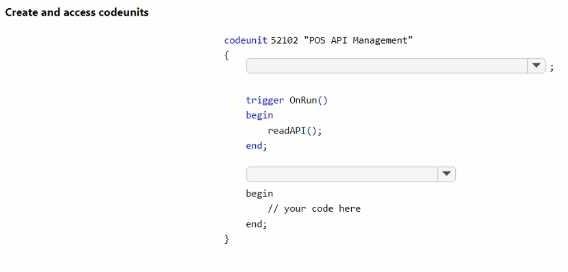Quiz
You need to download a stored picture from the Room Incident page.
How should you complete the code segment? To answer, select the appropriate options in the
answer area.
NOTE: Each correct selection is worth one point.
F
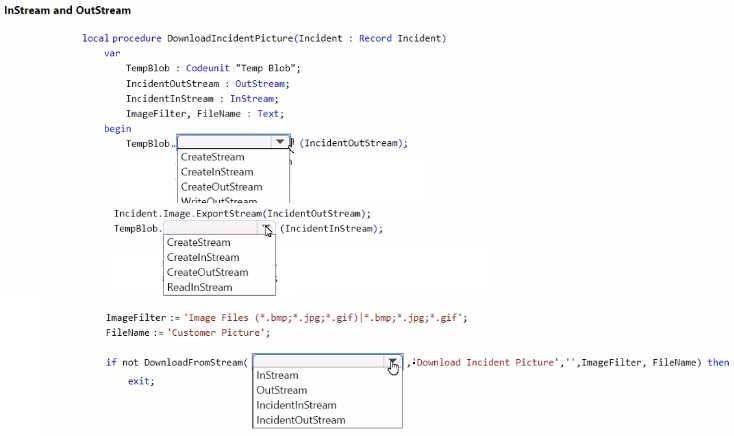
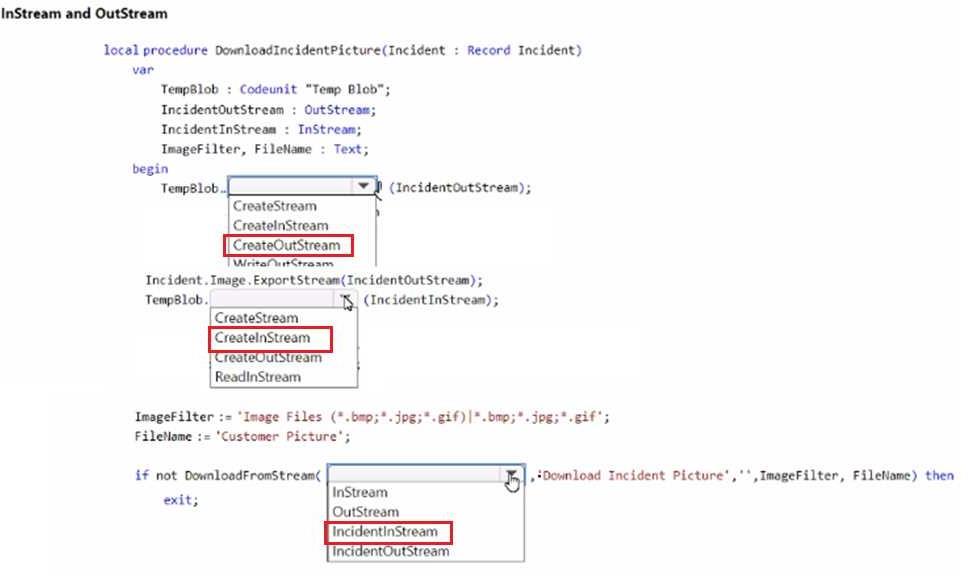
Quiz
You need to create the codeunit to read the POS terminal APIs.
How should you complete the code segment? To answer, select the appropriate options in the
answer area.
NOTE; Each correct selection is worth one point.
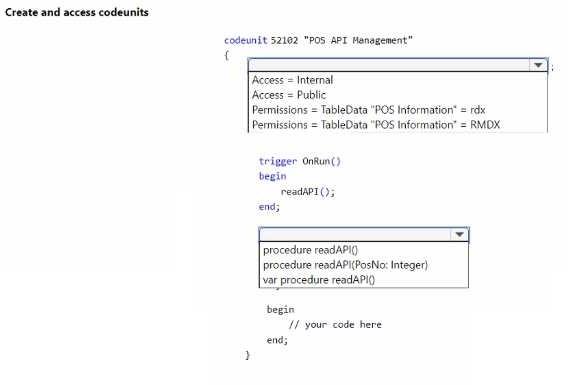
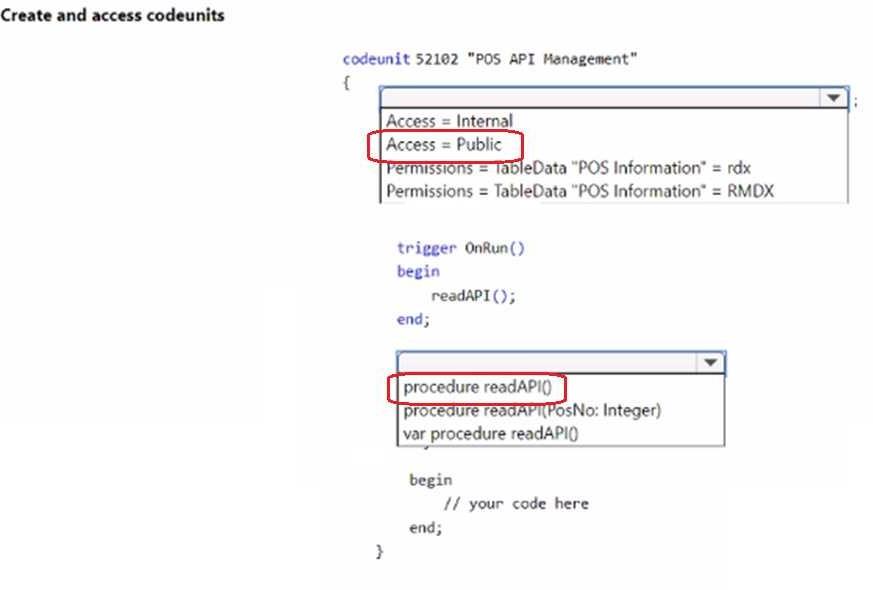
Quiz
You need to define the properties of the comments field of the Non-conformity page.
How should you complete the code segment? To answer, select the appropriate options in the
answer area.
NOTE; Each correct selection is worth one point.
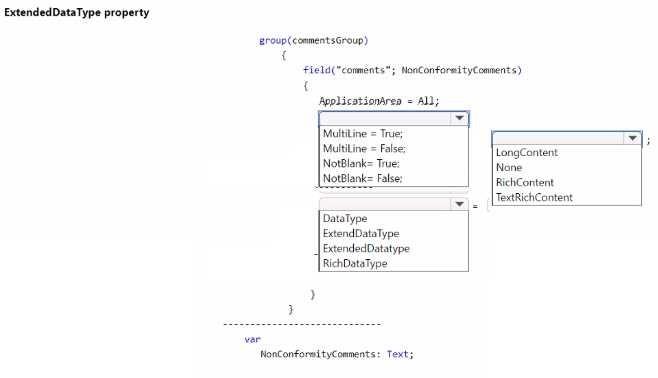
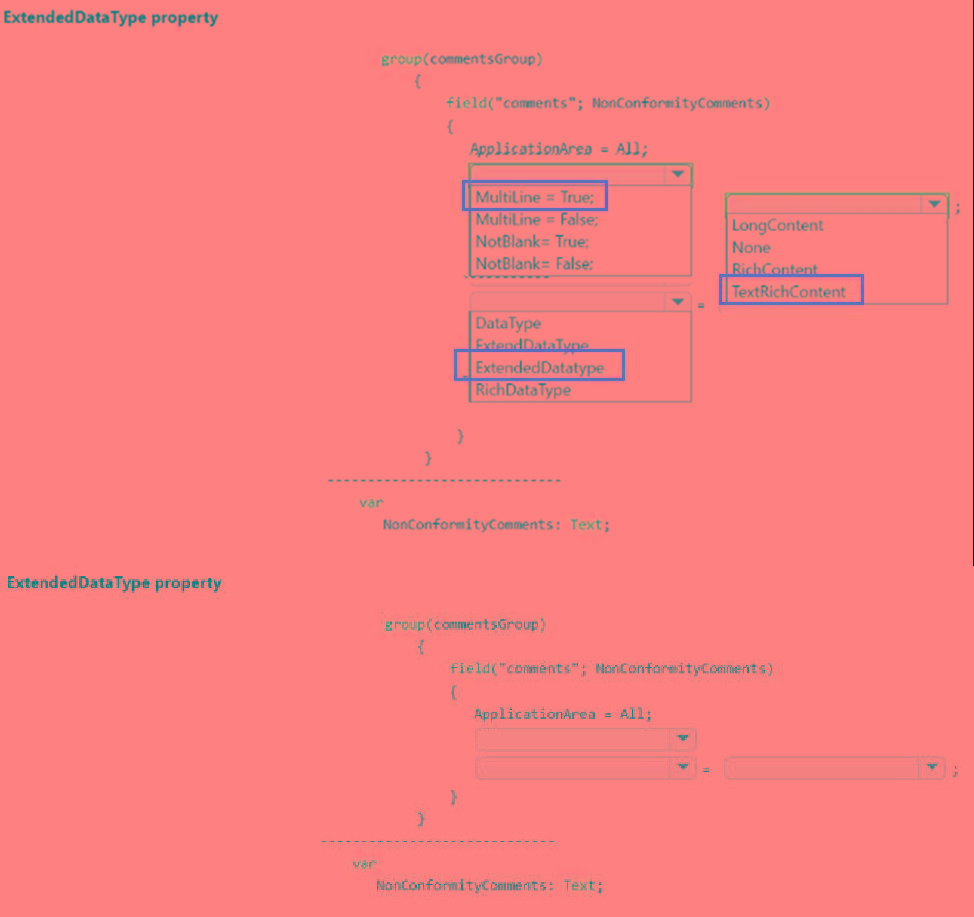
Quiz
Which two data types should you use? Each correct answer presents part of the solution.
NOTE: Each correct selection is worth one point.
Quiz
You need to create the Install codeunit that is requited in the extension used for installing or
updating the Housekeeping app.
Which data type or declaration should you use? To answer, select the appropriate options in the
answer area.
NOTE; Each correct selection is worth one point.

For the Install codeunit required for the extension used for installing or updating the Housekeeping
app, you should use the following data type and declaration:
Data type for information: ModuleInfo
Start of the declaration of the method or procedure to perform the tasks: local procedure
In AL language, which is used for developing extensions in Business Central, an Install codeunit is a
special type of codeunit that is used to handle installation or upgrade logic for an extension.
ModuleInfo is a data type that contains information about the current extension, such as its version.
It is typically used within the OnInstallAppPerCompany or OnUpgradePerCompany triggers of an
Install codeunit to determine if the app is being installed for the first time or upgraded.
A local procedure within an Install codeunit is a method that is only accessible within the codeunit
itself. It is not visible to other objects or extensions. This is suitable for tasks that are internal to the
installation process and should not be exposed globally.
These selections align with the requirements of handling installation and update procedures in a
controlled and encapsulated manner within Business Central extensions.
TESTLET-1.
Case Study Alpine Ski House
Overview
Alpine Ski House is a company that owns and operates hotels, restaurants, and stores. Currently, the
company uses the following software and interlace:
• Property management software (PMS) to manage hotel rooms
• On-premises accounting software to generate sales invoices and create purchase orders
• An API that allows restaurants and stores to obtain necessary information
Restaurants and stores use standalone software for point of sale (POS) devices. Each day, the POS
terminals generate a text file of sales data and save the files in a serval folder. An account assistant
must manually import the files to the current software tables to be processed by the system.
The general manager receives several reports monthly from department managers. The reports take
too much time to prepare.
The company is moving from a different system to 8usiness Central online to manage the whole
company.
The company plans to increase efficiency in every department by using APIs to obtain or share
information between the different systems.
Each department involved in purchasing must be able to make purchase requests automatically and
easily. The departments do not need access to the full ERP management system.
Alpine Ski House requires the development of several extensions for the planned improvements.
Business Central design patterns must be used to develop all extensions.
Alpine Ski House must develop the following pages:
• Pages that provide multiple configurations in a multistep dialog, like a wizard, to provide
required information when the extensions are first installed
• Department-specific Role Center pages to show relevant information and pages with additional
information
The IT department plans to use Power 61 to analyze departmental information. The database must
be configured to provide optimal performance.
The housekeeping department requires the following to increase efficiency and help avoid data entry
errors:
• A Housekeeping Role Center to minimize navigation to relevant areas In Business Central online
and to show relevant information in it
• Pages to embed into a new Room page to show additional information about the Room entity
• A table named Room Incident for the housekeeping team to enter room issue information
• A Housekeeping canvas app that connects to an extension
The department requires the development of an extension with a new API page named RoomsAPI.
• The housekeeping team will use RoomsAPI to publish room details, update when work is
complete, or provide repair notifications from the canvas app.
• This custom API page must expose a custom table named Rooms and have an ID 50000. The
table must be able to update from the PMS. The PMS team must know the end to connect to the
custom API.
• A developer provides the following details for the API page:
APIPublisher = 'alpine';
APIGroup - 'integration';
APIVersion - 'v2.6';
fntityName ■ 'room';
EntitySetName = 'rooms';
• The extension must be published in Business Central online and include a list page named Room
List that includes all hotel rooms.
• Installation or updates to this extension must meet the following requirements:
o Some web services must be published automatically.
o The version of the specified application's metadata must be obtained in AL language.
o The code required to perform tasks cannot be accessible from other parts of the application.
The Room Incident table information must include the following fields:
• Incident entry: An incremental number
• Room No.: A room from the Room table
• Incident Date: The work date
o The table definition in the Room Incident table must autofill the Incident Date when the
housekeeping team inserts a new record, o The value for Incident Date must be the work date
configured in the Business Central online client.
• Status: Includes the following options lo identify the status of the incident:
o Open: When the Room Incident is created
o In Progress: When someone starts repair work
o Closed: When the incident is solved
• Incident Closing Date: Auto-updating field (when the status passes to Closed, the field will
update with the work date)
• Incident Description: Text
• Image. Media data type
o The stored picture must be downloadable from a menu action.
o A Room Incident page must be developed to contain the download action.
To increase efficiency, the new system must manage the generated data from the restaurants and
stores directly by using the API on the POS terminals.
• The company requires a code unit called from a job queue to read the information from the POS
terminal APIs.
• The POS terminal information must be stored in a table named POS Information, have an ID
50100. and be editable on a page.
• The account manager requires an option on the menu of the page to run the process manually.
To analyze the information received from the POS terminals, the company requires:
• A custom API named ticketAPI to export the information to Power BI
• Use of the Read Scale-Out feature to improve database performance
The purchasing department requites a new entity in Business Central online to log non-conformities
of goods received from vendors. The entity must be set up as follows:
• The non-conformity entity must have two tables:
o a header with common information
o one or more lines with the detailed received items that are non-conforming
• The entity requires a page named Non-conformity and a subpage named Non-Conformity Lines
to store the information.
When a purchase order with incorrect quantity 01 quality issues is received, the entity must create a
non-conformity document in the system. The following information must be nick the document:
• Non-conformity Number: must use the No. Series table from Business Central online to manage
this field and use these features:
o Alphanumeric values
o Number format that includes "NO and the year as part of the number: for example, NC24-001
• Non-conformity Date: stores only the creation date
• Vendor No.: stores the number of the vendor that sent the items; only vendors from the
company must be included
• Owner: code of an employee defined in the company
• Receipt No.: must meet the following conditions:
o Be an existing receipt No.
o Be received from the vendor indicated in the Vendor No. field
• Comments: can include comments with rich text and pictures to illustrate quality problems »
• Status: includes nonconformity statuses, such as:
o Open
o Notified
o Closed
• Lines must contain the following details:
o Item No.: item received (for existing inventory items only)
o Description: item description
0 Quantity: non-conforming quantity
0 Non-conformity Type:
■ Quality
■ Quantity
■ Delivery date
The serial numbers of the non-conformities and the period in which they can be created must be in a
configuration table and its corresponding page to allow them to be modified for the users.
Quiz
You need to select the appropriate page types to solve the reporting requirements.
Which page types should you use? To answer, select the appropriate options in the answer area.
NOTE; Each correct selection is worth one point.
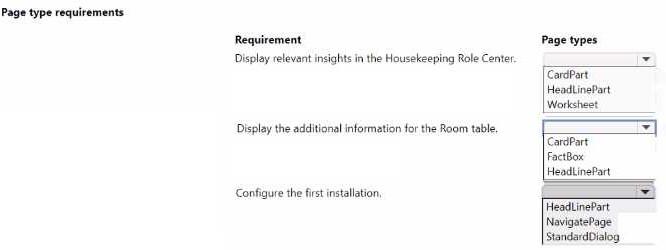
For the requirements provided, the appropriate page types should be selected as follows:
Display relevant insights in the Housekeeping Role Center: HeadlinePart
Display the additional information for the Room table: FactBox
Configure the first installation: StandardDialog
Comprehensive Detailed Explanation
In the context of Microsoft Dynamics 365 Business Central, page types are crucial for determining
how information is presented to the user.
HeadlinePart: This page type is designed to display key data and insights in a concise and visually
appealing manner, often used in Role Centers to highlight important information. It is suitable for the
Housekeeping Role Center to display relevant insights.
FactBox: This page type is used to display supplementary information related to a selected record in
the main part of the page. It's often used to show additional details about a record in a list, card, or
document page. In this scenario, it is suitable for showing additional information about a specific
Room when viewing the Room table.
StandardDialog: This is a page type that provides a modal dialog for user interaction, commonly used
for setup wizards, confirmations, and input forms that require user action before proceeding. This is
appropriate for configuring the first installation, where a step-by-step guided interaction is necessary.
TESTLET-2.
Contoso, Ltd.
Overview
Contoso, Ltd. Is a sales company in the manufacturing industry. It has subsidiaries in multiple
countries/regions, each with its own localization. The subsidiaries must be data-independent from
each other. Contoso. Ltd. uses an external business partner to manage the subcontracting of some
manufacturing items. Contoso. Ltd. has different sectors with data security between sectors required.
Contoso, Ltd. uses Business Central online as the main ERP for financial. sales, purchase, warehouse,
and manufacturing processes. It has employees that use the Business Central web application and
external applications. The company has a custom external mobile app under development
The IT department and its partners installed custom extensions to satisfy the company's
requirements where the functionality is not available natively.
Contoso. Ltd. interacts with external services provided by customers and partners. Different
applications interact with SOAP and OData endpoints exposed from Business Central.
An external business partner of Contoso, Ltd exposed a REST API for receiving details about new
subcontracting orders and for sending the planned release date of each subcontracting order
received.
Contoso. Ltd. has not activated the monitoring of the tenant and has no internal telemetry for its
apps.
Custom reporting must be created to meet the requirements of the different departments.
Contoso, Ltd. has the following tenant management considerations:
IT department
• The IT department requires the ability to monitor the tenant to prevent performance problems
and detect possible anomalies.
• The IT department plans to use Azure Application Insights and Log Analytics to inspect the
ingested telemetry signals.
• All tenant upgrades are automatically handled by Microsoft. The IT department does not check
for update availability or for tenant-related notifications.
• The IT department has not configured the receipt of tenant-related notifications from the
Business Central admin center.
External business partner
• The external business partner must add custom telemetry to an application created for Contoso.
Ltd. to monitor a business process.
• Custom telemetry signals for the application must be visible only on the partner's telemetry.
SOAP
• Contoso, Ltd. plans to dismiss using the SOAP protocol for integrations.
• Contoso, Ltd. must be able to detect if external applications are using its Business Central SOAP
endpoints.
Issue
The Business Central tenant is upgraded by Microsoft to a new major version during the night.
Users report that one of the Contoso. ltd. extensions disappeared from the tenant The IT department
confirms that the extension is still published.
Contoso. Ltd. plans to create a custom mobile application that has the following requirements:
• The app must be used by employees to check item details from the ERP in real time and to
report issues that occur during the manufacturing process.
• An AL extension must be created for handling archived issues.
• Business Central development guidelines must be followed when implementing modules.
• A module must be implemented for the reporting and tracking of issues information. You plan to
call this module Issue Management The module must expose a method nan Postlude.
• Code modifications will be required over time.
• The Issue Management process must be split into two extensions:
o ISSUE BASE: main extension
o ISSUE EXT: second extension with dependency from ISSUE BASE
• In the version 1.0.0.0 of the ISSUE BASE extension, you plan to create an Issue table that
contains a global Decimal variable named Issue Total.
• In the version 1.0.0.0 of the ISSUE BASE extension, you plan to define a table named Issue
Category with a Description field defined as follows:
field (2; Description; Text[SG])
{
DataClassificstion * CustoaerContent;
>
• The Issue table defined in ISSUE BASE extension contains a Clone procedure defined as follows:
procedure Corte () begin end;
• In the ISSUE EXT extension, you create a table extension object of the Issue table.
• The table extension object of the Issue table must access the Issue Total: Decimal variable.
After weeks of usage, you discover that you must remove the Description field and the Clone
procedure because they are no longer required.
In a new version of the ISSUE BASE extension, you create a new Issue Type table. You must move
data row by row from a previously obsolete Issue Category table to the new Issue Type table.
Because a large amount of data must be moved, you must write an Upgrade codeunit by using the
DataTransfer object.
The IT department creates a custom API for exposing the custom Issue table. The API provides an
action for copying an issue to a new table. The action is defined as follows:
(Service Enabled]
procedure Copy (vary action Context: WebServiceActionContext)
begin
end;
Contoso, Ltd. must create an API in Business Central to expose item details to the mobile application.
• The API must have the lowest possible impact on the production environment when used during
working hours.
• The API must only support Get operations.
A user of the ISSUE BASE extension in Business Central reports a problem.
To debug the problem, snapshot debugging with the following configuration was activated:
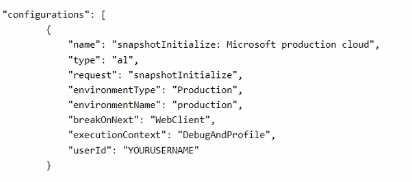
You discover that the debugging is not triggering.
Contoso, Ltd. must connect Business Central to the external API provided by the business partner.
This will be used for the partner to send the details of new subcontracting orders to fulfill the sales
demand, and for receiving the planned release date of each order sent. The integration requirements
are as follows:
• The business partner will provide a REST API secured with basic authentication. Credentials to
access the API will be shared with Contoso, ltd.
• The API for sending subcontracting orders must be called by sending an authenticated POST
request to the given endpoint.
• The API for retrieving the order no. and planned release date of each subcontracting order
responds with the following JSON:
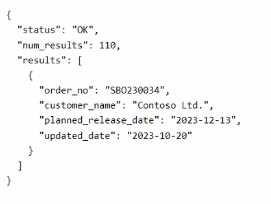
Each order no. must be retrieved.
Quiz
You need to handle the removal of the Description field and the Clone procedure without breaking
other extensions.
Which three actions should you perform in sequence? To answer, move the appropriate actions from
the list of actions to the answer area and arrange them in the correct order.
NOTE: More than one order of answer choices is correct. You will receive credit for any of the correct
orders you select.

In Business Central, when you need to handle the removal of fields and procedures to ensure that
other extensions are not affected by these changes, you typically follow a two-step deprecation
process. This allows other developers and users to adapt to the changes before they are fully
enforced. Here are the steps to handle the removal:
Mark as Obsolete: In the first version where the decision to remove the field or procedure is made,
you set the ObsoleteState to Pending and provide an ObsoleteReason. This doesn't remove the
feature but indicates to users and developers that it will be removed in the future. This step is crucial
for backward compatibility.
Removal: In a subsequent version, after users have had time to adapt to the deprecation warning,
you can then remove the field or procedure or set the ObsoleteState to Removed.
Based on these guidelines, here are the three actions you should perform in sequence:
Set the Description field as ObsoleteState = Pending and ObsoleteReason = 'Not in use' in version
2.0.0.0.
Set the Clone procedure as ObsoleteState = Pending and ObsoleteReason = 'Not in use' in version
2.0.0.0.
Remove the Description field from the Issue table in version 2.0.0.1.
These steps will ensure that anyone using the Description field or Clone procedure will receive a
warning about the pending deprecation before it is actually removed, thereby minimizing the impact
on other extensions and providing a clear path for migration.
When handling the removal of fields and procedures in Microsoft Dynamics 365 Business Central, the
process should be carried out in a way that allows other extensions or dependent features to adapt
to the changes without causing immediate failures.
Set Obsolete State and Reason for Description Field (Version 2.0.0.0): The first step involves marking
the Description field as obsolete by setting the ObsoleteState to 'Pending'. This is a non-breaking
change, signaling to other developers and users that the field is planned for removal in a future
version. An ObsoleteReason should also be provided to explain why the field is being deprecated.
Set Obsolete State and Reason for Clone Procedure (Version 2.0.0.0): Similarly, the Clone procedure
should be marked as obsolete with the ObsoleteState set to 'Pending'. This indicates that the
procedure is no longer in use and will be removed in the future. Providing an ObsoleteReason is best
practice as it explains the rationale behind the decision.
Remove the Description Field (Version 2.0.0.1): In the subsequent version, after the developers and
users have been given time to adapt to the deprecation notice, the Description field can be safely
removed from the Issue table. This is considered a breaking change, hence it is done after the field
has been marked as obsolete in a previous version.
The reason for not removing the Description field and Clone procedure immediately in version
2.0.0.0 is to avoid causing runtime errors for any extensions or integrations that may depend on
these components. By following this sequence, you provide a clear deprecation path that helps
maintain the stability of the overall system while evolving the schema.
TESTLET-2.
Contoso, Ltd.
Overview
Contoso, Ltd. Is a sales company in the manufacturing industry. It has subsidiaries in multiple
countries/regions, each with its own localization. The subsidiaries must be data-independent from
each other. Contoso. Ltd. uses an external business partner to manage the subcontracting of some
manufacturing items. Contoso. Ltd. has different sectors with data security between sectors required.
Contoso, Ltd. uses Business Central online as the main ERP for financial. sales, purchase, warehouse,
and manufacturing processes. It has employees that use the Business Central web application and
external applications. The company has a custom external mobile app under development
The IT department and its partners installed custom extensions to satisfy the company's
requirements where the functionality is not available natively.
Contoso. Ltd. interacts with external services provided by customers and partners. Different
applications interact with SOAP and OData endpoints exposed from Business Central.
An external business partner of Contoso, Ltd exposed a REST API for receiving details about new
subcontracting orders and for sending the planned release date of each subcontracting order
received.
Contoso. Ltd. has not activated the monitoring of the tenant and has no internal telemetry for its
apps.
Custom reporting must be created to meet the requirements of the different departments.
Contoso, Ltd. has the following tenant management considerations:
IT department
• The IT department requires the ability to monitor the tenant to prevent performance problems
and detect possible anomalies.
• The IT department plans to use Azure Application Insights and Log Analytics to inspect the
ingested telemetry signals.
• All tenant upgrades are automatically handled by Microsoft. The IT department does not check
for update availability or for tenant-related notifications.
• The IT department has not configured the receipt of tenant-related notifications from the
Business Central admin center.
External business partner
• The external business partner must add custom telemetry to an application created for Contoso.
Ltd. to monitor a business process.
• Custom telemetry signals for the application must be visible only on the partner's telemetry.
SOAP
• Contoso, Ltd. plans to dismiss using the SOAP protocol for integrations.
• Contoso, Ltd. must be able to detect if external applications are using its Business Central SOAP
endpoints.
Issue
The Business Central tenant is upgraded by Microsoft to a new major version during the night.
Users report that one of the Contoso. ltd. extensions disappeared from the tenant The IT department
confirms that the extension is still published.
Contoso. Ltd. plans to create a custom mobile application that has the following requirements:
• The app must be used by employees to check item details from the ERP in real time and to
report issues that occur during the manufacturing process.
• An AL extension must be created for handling archived issues.
• Business Central development guidelines must be followed when implementing modules.
• A module must be implemented for the reporting and tracking of issues information. You plan to
call this module Issue Management The module must expose a method nan Postlude.
• Code modifications will be required over time.
• The Issue Management process must be split into two extensions:
o ISSUE BASE: main extension
o ISSUE EXT: second extension with dependency from ISSUE BASE
• In the version 1.0.0.0 of the ISSUE BASE extension, you plan to create an Issue table that
contains a global Decimal variable named Issue Total.
• In the version 1.0.0.0 of the ISSUE BASE extension, you plan to define a table named Issue
Category with a Description field defined as follows:
field (2; Description; Text[SG])
{
DataClassificstion * CustoaerContent;
>
• The Issue table defined in ISSUE BASE extension contains a Clone procedure defined as follows:
procedure Corte () begin end;
• In the ISSUE EXT extension, you create a table extension object of the Issue table.
• The table extension object of the Issue table must access the Issue Total: Decimal variable.
After weeks of usage, you discover that you must remove the Description field and the Clone
procedure because they are no longer required.
In a new version of the ISSUE BASE extension, you create a new Issue Type table. You must move
data row by row from a previously obsolete Issue Category table to the new Issue Type table.
Because a large amount of data must be moved, you must write an Upgrade codeunit by using the
DataTransfer object.
The IT department creates a custom API for exposing the custom Issue table. The API provides an
action for copying an issue to a new table. The action is defined as follows:
(Service Enabled]
procedure Copy (vary action Context: WebServiceActionContext)
begin
end;
Contoso, Ltd. must create an API in Business Central to expose item details to the mobile application.
• The API must have the lowest possible impact on the production environment when used during
working hours.
• The API must only support Get operations.
A user of the ISSUE BASE extension in Business Central reports a problem.
To debug the problem, snapshot debugging with the following configuration was activated:

You discover that the debugging is not triggering.
Contoso, Ltd. must connect Business Central to the external API provided by the business partner.
This will be used for the partner to send the details of new subcontracting orders to fulfill the sales
demand, and for receiving the planned release date of each order sent. The integration requirements
are as follows:
• The business partner will provide a REST API secured with basic authentication. Credentials to
access the API will be shared with Contoso, ltd.
• The API for sending subcontracting orders must be called by sending an authenticated POST
request to the given endpoint.
• The API for retrieving the order no. and planned release date of each subcontracting order
responds with the following JSON:

Each order no. must be retrieved.
Quiz
last seven days.
Which two KQL queries should you use? Each correct answer presents a complete solution.
NOTE: Each correct selection is worth one point.





Quiz
cause it to disappear after an upgrade because DEV extensions are intended for development and
testing within sandbox environments.
Quiz
You need to configure telemetry for the SaaS tenant and test whether the ingested signals are
displayed.
Which three actions should you perform in sequence? To answer, move the appropriate actions from
the list of actions to the answer area and arrange them in the correct order.

The correct sequence of actions to configure telemetry for the SaaS tenant and test whether the
ingested signals are displayed would be:
Create an Azure Application Insights instance by using the Azure Portal in the Customer's
subscription.
Select the environment in the Admin Center and place the connection string in the Application
Insights Connection String field.
Select the Application Insights instance, select Logs and then inspect the Traces table.
To set up telemetry for a SaaS tenant using Azure Application Insights, you need to follow these
steps:
Create an Azure Application Insights instance: This is the first step where you create an instance in
Azure that will collect the telemetry dat
a. This should be done in the customer's Azure subscription because it's their data that you're
monitoring.
Configure the SaaS tenant to use the created Application Insights instance: This involves entering the
correct connection string in the Business Central Admin Center so that telemetry data from the
tenant is sent to the Application Insights instance.
Verify that telemetry is being collected: After configuring, you would check if the telemetry is
arriving as expected by inspecting the Traces table in the Azure Application Insights instance. The
'Traces' table holds the telemetry data, which you can query to verify that the correct signals are
being ingested.
TESTLET-2.
Contoso, Ltd.
Overview
Contoso, Ltd. Is a sales company in the manufacturing industry. It has subsidiaries in multiple
countries/regions, each with its own localization. The subsidiaries must be data-independent from
each other. Contoso. Ltd. uses an external business partner to manage the subcontracting of some
manufacturing items. Contoso. Ltd. has different sectors with data security between sectors required.
Contoso, Ltd. uses Business Central online as the main ERP for financial. sales, purchase, warehouse,
and manufacturing processes. It has employees that use the Business Central web application and
external applications. The company has a custom external mobile app under development
The IT department and its partners installed custom extensions to satisfy the company's
requirements where the functionality is not available natively.
Contoso. Ltd. interacts with external services provided by customers and partners. Different
applications interact with SOAP and OData endpoints exposed from Business Central.
An external business partner of Contoso, Ltd exposed a REST API for receiving details about new
subcontracting orders and for sending the planned release date of each subcontracting order
received.
Contoso. Ltd. has not activated the monitoring of the tenant and has no internal telemetry for its
apps.
Custom reporting must be created to meet the requirements of the different departments.
Contoso, Ltd. has the following tenant management considerations:
IT department
• The IT department requires the ability to monitor the tenant to prevent performance problems
and detect possible anomalies.
• The IT department plans to use Azure Application Insights and Log Analytics to inspect the
ingested telemetry signals.
• All tenant upgrades are automatically handled by Microsoft. The IT department does not check
for update availability or for tenant-related notifications.
• The IT department has not configured the receipt of tenant-related notifications from the
Business Central admin center.
External business partner
• The external business partner must add custom telemetry to an application created for Contoso.
Ltd. to monitor a business process.
• Custom telemetry signals for the application must be visible only on the partner's telemetry.
SOAP
• Contoso, Ltd. plans to dismiss using the SOAP protocol for integrations.
• Contoso, Ltd. must be able to detect if external applications are using its Business Central SOAP
endpoints.
Issue
The Business Central tenant is upgraded by Microsoft to a new major version during the night.
Users report that one of the Contoso. ltd. extensions disappeared from the tenant The IT department
confirms that the extension is still published.
Contoso. Ltd. plans to create a custom mobile application that has the following requirements:
• The app must be used by employees to check item details from the ERP in real time and to
report issues that occur during the manufacturing process.
• An AL extension must be created for handling archived issues.
• Business Central development guidelines must be followed when implementing modules.
• A module must be implemented for the reporting and tracking of issues information. You plan to
call this module Issue Management The module must expose a method nan Postlude.
• Code modifications will be required over time.
• The Issue Management process must be split into two extensions:
o ISSUE BASE: main extension
o ISSUE EXT: second extension with dependency from ISSUE BASE
• In the version 1.0.0.0 of the ISSUE BASE extension, you plan to create an Issue table that
contains a global Decimal variable named Issue Total.
• In the version 1.0.0.0 of the ISSUE BASE extension, you plan to define a table named Issue
Category with a Description field defined as follows:
field (2; Description; Text[SG])
{
DataClassificstion * CustoaerContent;
>
• The Issue table defined in ISSUE BASE extension contains a Clone procedure defined as follows:
procedure Corte () begin end;
• In the ISSUE EXT extension, you create a table extension object of the Issue table.
• The table extension object of the Issue table must access the Issue Total: Decimal variable.
After weeks of usage, you discover that you must remove the Description field and the Clone
procedure because they are no longer required.
In a new version of the ISSUE BASE extension, you create a new Issue Type table. You must move
data row by row from a previously obsolete Issue Category table to the new Issue Type table.
Because a large amount of data must be moved, you must write an Upgrade codeunit by using the
DataTransfer object.
The IT department creates a custom API for exposing the custom Issue table. The API provides an
action for copying an issue to a new table. The action is defined as follows:
(Service Enabled]
procedure Copy (vary action Context: WebServiceActionContext)
begin
end;
Contoso, Ltd. must create an API in Business Central to expose item details to the mobile application.
• The API must have the lowest possible impact on the production environment when used during
working hours.
• The API must only support Get operations.
A user of the ISSUE BASE extension in Business Central reports a problem.
To debug the problem, snapshot debugging with the following configuration was activated:

You discover that the debugging is not triggering.
Contoso, Ltd. must connect Business Central to the external API provided by the business partner.
This will be used for the partner to send the details of new subcontracting orders to fulfill the sales
demand, and for receiving the planned release date of each order sent. The integration requirements
are as follows:
• The business partner will provide a REST API secured with basic authentication. Credentials to
access the API will be shared with Contoso, ltd.
• The API for sending subcontracting orders must be called by sending an authenticated POST
request to the given endpoint.
• The API for retrieving the order no. and planned release date of each subcontracting order
responds with the following JSON:

Each order no. must be retrieved.
Microsoft Dynamics 365 Business Central Developer Practice test unlocks all online simulator questions
Thank you for choosing the free version of the Microsoft Dynamics 365 Business Central Developer practice test! Further deepen your knowledge on Microsoft Simulator; by unlocking the full version of our Microsoft Dynamics 365 Business Central Developer Simulator you will be able to take tests with over 53 constantly updated questions and easily pass your exam. 98% of people pass the exam in the first attempt after preparing with our 53 questions.
BUY NOWWhat to expect from our Microsoft Dynamics 365 Business Central Developer practice tests and how to prepare for any exam?
The Microsoft Dynamics 365 Business Central Developer Simulator Practice Tests are part of the Microsoft Database and are the best way to prepare for any Microsoft Dynamics 365 Business Central Developer exam. The Microsoft Dynamics 365 Business Central Developer practice tests consist of 53 questions and are written by experts to help you and prepare you to pass the exam on the first attempt. The Microsoft Dynamics 365 Business Central Developer database includes questions from previous and other exams, which means you will be able to practice simulating past and future questions. Preparation with Microsoft Dynamics 365 Business Central Developer Simulator will also give you an idea of the time it will take to complete each section of the Microsoft Dynamics 365 Business Central Developer practice test . It is important to note that the Microsoft Dynamics 365 Business Central Developer Simulator does not replace the classic Microsoft Dynamics 365 Business Central Developer study guides; however, the Simulator provides valuable insights into what to expect and how much work needs to be done to prepare for the Microsoft Dynamics 365 Business Central Developer exam.
BUY NOWMicrosoft Dynamics 365 Business Central Developer Practice test therefore represents an excellent tool to prepare for the actual exam together with our Microsoft practice test . Our Microsoft Dynamics 365 Business Central Developer Simulator will help you assess your level of preparation and understand your strengths and weaknesses. Below you can read all the quizzes you will find in our Microsoft Dynamics 365 Business Central Developer Simulator and how our unique Microsoft Dynamics 365 Business Central Developer Database made up of real questions:
Info quiz:
- Quiz name:Microsoft Dynamics 365 Business Central Developer
- Total number of questions:53
- Number of questions for the test:50
- Pass score:80%
You can prepare for the Microsoft Dynamics 365 Business Central Developer exams with our mobile app. It is very easy to use and even works offline in case of network failure, with all the functions you need to study and practice with our Microsoft Dynamics 365 Business Central Developer Simulator.
Use our Mobile App, available for both Android and iOS devices, with our Microsoft Dynamics 365 Business Central Developer Simulator . You can use it anywhere and always remember that our mobile app is free and available on all stores.
Our Mobile App contains all Microsoft Dynamics 365 Business Central Developer practice tests which consist of 53 questions and also provide study material to pass the final Microsoft Dynamics 365 Business Central Developer exam with guaranteed success. Our Microsoft Dynamics 365 Business Central Developer database contain hundreds of questions and Microsoft Tests related to Microsoft Dynamics 365 Business Central Developer Exam. This way you can practice anywhere you want, even offline without the internet.
BUY NOW